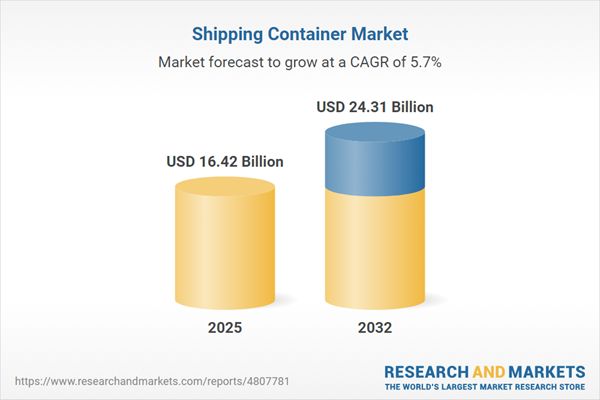Speak directly to the analyst to clarify any post sales queries you may have.
The global shipping container market is shifting as organizations face intricate logistics, regulatory changes, and growing sustainability mandates. Senior decision-makers need agile strategies to maintain supply chain resilience and capitalize on value within evolving global trade environments.
Market Snapshot: Shipping Container Market Size and Growth
The shipping container market continues its upward trajectory, valued at USD 15.62 billion in 2024 and forecasted to reach USD 16.42 billion in 2025 and USD 24.31 billion by 2032, reflecting a robust compound annual growth rate (CAGR) of 5.68%. This steady increase highlights persistent demand for containerized solutions, with sector expansion propelled by advancing logistics technologies and continuous adaptation to new trading landscapes.
Scope & Segmentation of the Shipping Container Market
This comprehensive analysis presents a strategic segmentation of the shipping container market, providing organizations with actionable clarity for operational and investment planning across diverse logistics networks.
- Container Types: Dry, refrigerated, and specialized containers enable tailored solutions for standard, temperature-sensitive, and high-value cargo, supporting flexible supply chain designs.
- Material Types: Options include steel for strength, aluminum for energy-efficient weight reduction, and fiber-reinforced polymers with advanced corrosion resistance for demanding environments.
- Container Sizes: Selection spans flat rack and high-cube for oversized loads, standard 40ft for intercontinental trade, and compact 20ft for regional and urban logistics.
- Ownership Models: Carrier owned containers are integrated for scheduled shipping lines, while shipper owned options offer customizable control and adaptability in deployment.
- Applications: Containers serve sectors such as chemicals, consumer goods, electronics, food and beverages, healthcare, and machinery, delivering value through sector-specific design and regulatory compliance.
- End-User Industries: Demand is shaped by agriculture, automotive, energy, manufacturing, and retail, each with unique shipment and inventory management needs.
- Regional Coverage: Analysis spans the Americas, Europe, Middle East and Africa, and Asia-Pacific, with deep dives into individual markets like the United States, China, Germany, Japan, Australia, and Brazil, responding to shifting trade flows and regulatory frameworks.
- Key Companies: Leading providers include Ab Sea Container Private Limited, APPL Containers Pvt. Ltd., China Eastern Containers, China International Marine Containers (Group) Ltd., CXIC Group Containers Company Limited, DCM Hyundai Limited, Dong Fang International Container Co. Ltd., IWES Ltd., J K Technologies Private Limited, Kalyani Cast Tech Pvt. Ltd., KEN Containers, OEG Offshore Limited, Ritveyraaj Cargo Shipping Containers, Sea Box Inc., Silversea Container, Singamas Container Holdings Limited, Thurston Group, TLS Offshore Containers International Pvt Ltd, Valisons & Co., and W&K Containers Inc.
Key Takeaways for Senior Decision-Makers
- Modular, standardized designs facilitate rapid deployment, supporting operational agility and efficiency across supply chains adapting to global demands.
- Integration of IoT and blockchain technologies enables real-time tracking and enhanced data security, offering continual supply chain transparency and process improvement.
- Innovative materials such as composites and low-emission components assist in satisfying regulatory requirements while reinforcing sustainability strategies.
- Temperature-controlled container adoption is rising, meeting stringent standards for sensitive goods, particularly in sectors like pharmaceuticals and perishables.
- Automated processes and advanced analytics are helping to alleviate bottlenecks in port operations, optimizing asset utilization and fostering continuous improvement across large-scale shipping operations.
- Strategic investment in modern port infrastructure and streamlined trade corridors is enhancing global market connectivity and reinforcing compliance with varying regional standards.
Tariff Impact: Evolving Cost Structures and Route Strategies
U.S. tariff policy changes are reshaping international shipping patterns, motivating providers to recalibrate routes and pricing to address shifting cost structures. Importers using specialized containers are particularly affected, prompting many logistics teams to consolidate shipments, improve inland distribution flow, and realign regional manufacturing. These proactive strategies are proving effective in mitigating tariff-related risks and sustaining profit margins despite regulatory volatility.
Methodology & Data Sources
This report leverages first-hand interviews with industry experts, extensive secondary research from credible institutions, and sophisticated quantitative models. All data undergoes rigorous triangulation and validation, with confidentiality ensured at each stage of the research process.
Why This Report Matters
- Equips executives with segmentation, geographic trends, and company profiles tailored for strategic decisions in the container industry.
- Provides actionable insight into digital transformation, regulatory shifts, and sustainable material adoption, giving organizations practical tools for competitive positioning.
- Supports scenario planning for tariff changes or new technology adoption, enabling business leaders to approach complex global markets with confidence and foresight.
Conclusion
Senior leaders can use this market analysis to shape agile strategies and address supply chain complexities as the shipping container sector continues its dynamic evolution.
Additional Product Information:
- Purchase of this report includes 1 year online access with quarterly updates.
- This report can be updated on request. Please contact our Customer Experience team using the Ask a Question widget on our website.
Table of Contents
3. Executive Summary
4. Market Overview
7. Cumulative Impact of Artificial Intelligence 2025
List of Figures
Samples

LOADING...
Companies Mentioned
The key companies profiled in this Shipping Container market report include:- Ab Sea Container Private Limited
- APPL Containers Pvt. Ltd.
- China Eastern Containers
- China International Marine Containers (Group) Ltd.
- CXIC Group Containers Company Limited
- DCM Hyundai Limited
- Dong Fang International Container Co. Ltd.
- IWES Ltd.
- J K Technologies Private Limited
- Kalyani Cast Tech Pvt. Ltd.
- KEN Containers
- OEG Offshore Limited
- Ritveyraaj Cargo Shipping Containers
- Sea Box Inc.
- Silversea Container
- Singamas Container Holdings Limited
- Thurston Group
- TLS Offshore Containers International Pvt Ltd
- Valisons & Co.
- W&K Containers Inc.
Table Information
| Report Attribute | Details |
|---|---|
| No. of Pages | 188 |
| Published | October 2025 |
| Forecast Period | 2025 - 2032 |
| Estimated Market Value ( USD | $ 16.42 Billion |
| Forecasted Market Value ( USD | $ 24.31 Billion |
| Compound Annual Growth Rate | 5.6% |
| Regions Covered | Global |
| No. of Companies Mentioned | 21 |









